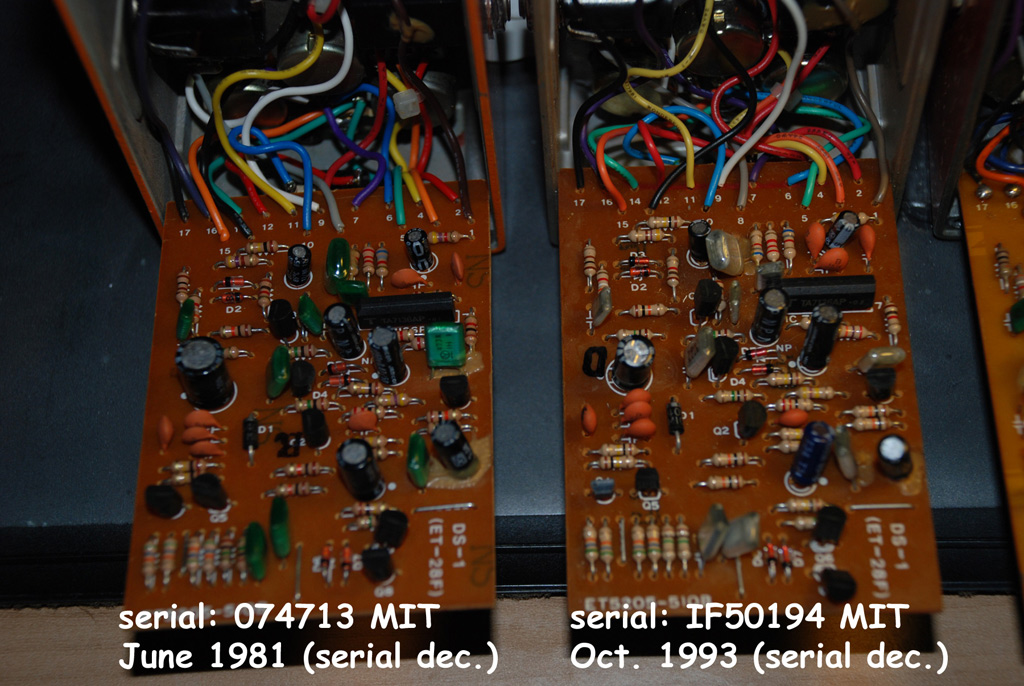thanks for all the input.I just want to get Both,my SD1 and DS1 as close to a MIJ as possible..They sound warmer and not as thin and buzzy as a MIT
Ad Widget
Collapse
Announcement
Collapse
No announcement yet.
How do you Fix a Pulled up Trase on PCB
Collapse
X
-
Well, changing two capacitors out for larger values will certainly affect the sound. It may well make it warmer, thicker, whatever.
But Juan says that the MIJ and MIT versions have exactly the same component values. ?!
One of you must be wrong: either the MIJ and MIT have different values, or they don't sound different. (Or the factory put in different parts than listed on the schematic, or the electrolytics had a really wide tolerance, etc etc...)
MIJ = Massachussets Institute of Juju, where wannabe effects gurus go to study. "Enzo, I see that you replied parasitic oscillations. Is that a hypothesis? Or is that your amazing metal band I should check out?"
"Enzo, I see that you replied parasitic oscillations. Is that a hypothesis? Or is that your amazing metal band I should check out?"
Comment
-
Well, it isn't only me who says so, let's look at some PCBs.
What amazes me is how *little* it has changed along the years and in different Countries.
"Little" as in "nothing".
Even the same PCB design, let alone the parts values.
Football minded Brazilians have a saying for this: "não mexe com Time ganhador" meaning "don't mess with a winning Team".
Only visible change, which does *not* affect sound, is that early Japanese ones added small eyelets on the external wiring points, later dropped them forever, and in latest units they replaced some wires with ribbon cable.
Japanese ones used their classic "dark green caps", Taiwanese used equally classic dark brown ones and a guy modded his with "Marshall approved" rectangular grey ones, so it has a more Marshally sound. Yea, sure.
MIT vs MIJ:
Poster makes a big deal that in one, a ceramic cap was labelled 241 , in the other it was 251
Just labelling, the cap is actually "250pF" or "240pF" same part and value, just that naming conventions change.
What used to be called .05uF, today is called .047 , simply to call it a "normalized" name.
I still get 250K pots; yet, say, newer Marshalls specify them as 220K , same thing, 220K is a normalized value.
Or old .025uF now is called .022uF . Same thing.

In fact, there's more difference between 2 Taiwanese ones !!! , simply because of the 12 years production date.
Anyway, what changes only is cap color and electrolytics have physically shrunk a little, maintaining same value.

In fact, the 1991 and 1993 ones add one small ceramic cap on the top right of the picture, probably an afterthought to damp some RF sensitivity.
Or *maybe* the latest ones used a more modern chip , with somewhat wider frequency range (similar to going from an LM741 in an original MXR Dist+ to a TL071 in a reissue) and adding, say, 10 to 27pF in parallel with the NFB resistors, not to change the sound, but to keep it the same, which sounds consistent with their already proven policy of *not* "messing" with it.
This is the one that now "sounds like a Marshall JCM800" (poster words, not mine)
Before and after:

Just some comments from the DS1 modders Forum:
I just found out, that Roland moved from Japan to Taiwan in the beginning of 1981. So, what´s the difference between this pedal and an original MIJ :scratch:
Sorry for asking that stupid question again and again, but to me, there seems to be no difference, regarding the pcbs. It has also the TA7136AP chip in it.The circuit changed in 1994, because they went from the original TA7136 (MIJ) *OR MIT* to later BA728N/M5223AL/NJM3404AL (post-1994 MIT)MIJ DS-1 were made in Japan from approximately 1978-1981. In 1981, production moved to Taiwan, but the circuit remain unchanged AFAIK.
So rather MIT vs MIJ, the key is beforeafter 1994 . Yet, the added small ceramic should about leave things about the same, or have a minuscule influence.
Certainly not going from an unbearable buzzsaw to a sweet warm smooth sound.
I bet the BIG difference is that many 1981 ones were hooked to balls to the walls Marshall stacks (and the reference is *recorded* (produced) sound), while the modern reference is DS1 hooked to combos or amps *not* used full tilt.
There must be one such explanation, because parts values and schematics are the same.Juan Manuel Fahey
Comment
-
Well, the original caps (the green or brown or "transparent silvery" ones) *were* "metal film" already, usually polyester or maybe expensive polycarbonate dielectric, but the actual capacitor plates are in all cases some variant of metal film, either an actual aluminum sheet or vacuum deposited aluminum.
As far as the capacitance value is the same, the circuit can't know which is which.
Of course, if you changed some values, varied some resistors and , biggest mod, went from Si diodes to Ge ones, the sound will appreciably change.
Good luck.Juan Manuel Fahey
Comment

Comment